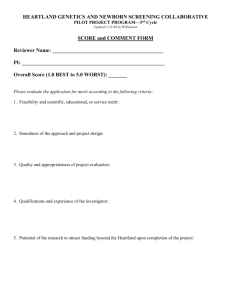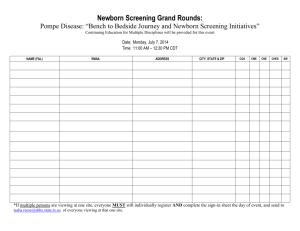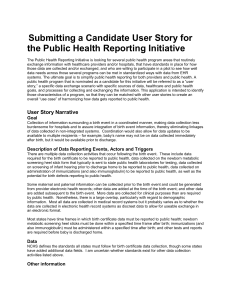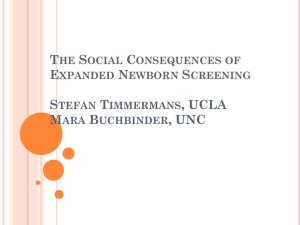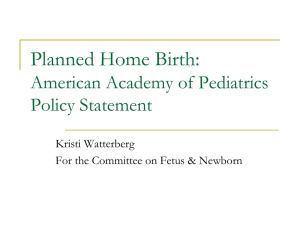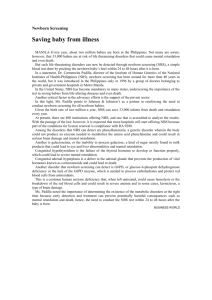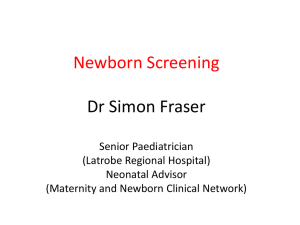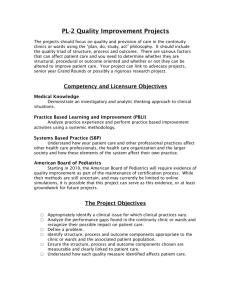Emergency Preparedness - New England Genetics Collaborative
advertisement
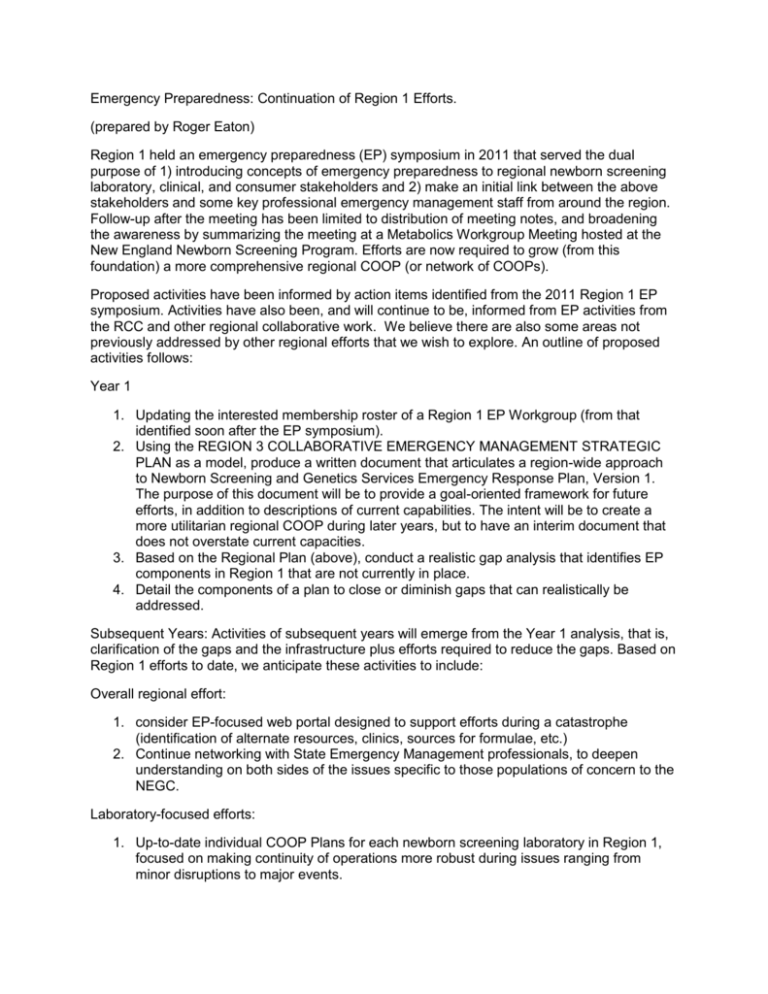
Emergency Preparedness: Continuation of Region 1 Efforts. (prepared by Roger Eaton) Region 1 held an emergency preparedness (EP) symposium in 2011 that served the dual purpose of 1) introducing concepts of emergency preparedness to regional newborn screening laboratory, clinical, and consumer stakeholders and 2) make an initial link between the above stakeholders and some key professional emergency management staff from around the region. Follow-up after the meeting has been limited to distribution of meeting notes, and broadening the awareness by summarizing the meeting at a Metabolics Workgroup Meeting hosted at the New England Newborn Screening Program. Efforts are now required to grow (from this foundation) a more comprehensive regional COOP (or network of COOPs). Proposed activities have been informed by action items identified from the 2011 Region 1 EP symposium. Activities have also been, and will continue to be, informed from EP activities from the RCC and other regional collaborative work. We believe there are also some areas not previously addressed by other regional efforts that we wish to explore. An outline of proposed activities follows: Year 1 1. Updating the interested membership roster of a Region 1 EP Workgroup (from that identified soon after the EP symposium). 2. Using the REGION 3 COLLABORATIVE EMERGENCY MANAGEMENT STRATEGIC PLAN as a model, produce a written document that articulates a region-wide approach to Newborn Screening and Genetics Services Emergency Response Plan, Version 1. The purpose of this document will be to provide a goal-oriented framework for future efforts, in addition to descriptions of current capabilities. The intent will be to create a more utilitarian regional COOP during later years, but to have an interim document that does not overstate current capacities. 3. Based on the Regional Plan (above), conduct a realistic gap analysis that identifies EP components in Region 1 that are not currently in place. 4. Detail the components of a plan to close or diminish gaps that can realistically be addressed. Subsequent Years: Activities of subsequent years will emerge from the Year 1 analysis, that is, clarification of the gaps and the infrastructure plus efforts required to reduce the gaps. Based on Region 1 efforts to date, we anticipate these activities to include: Overall regional effort: 1. consider EP-focused web portal designed to support efforts during a catastrophe (identification of alternate resources, clinics, sources for formulae, etc.) 2. Continue networking with State Emergency Management professionals, to deepen understanding on both sides of the issues specific to those populations of concern to the NEGC. Laboratory-focused efforts: 1. Up-to-date individual COOP Plans for each newborn screening laboratory in Region 1, focused on making continuity of operations more robust during issues ranging from minor disruptions to major events. 2. The creation of a separate Regional (or, more likely, inter-regional) back-up plan for catastrophic events, in the event that one or more NBS laboratory becomes temporarily inoperable. 3. Consideration of capacity to transmit laboratory data to alternative lab (both in anticipation of possible catastrophe, or back to “home” lab after crisis has waned), and accompanying security issues. 4. NBS laboratory catastrophe back-up drill. This will be informed by the plan described in step 2 above. The timing for this drill will be not prior to late 2013, to make most efficient use of data transmission drills, as the New England Newborn Screening Program is currently in the midst of replacing its current laboratory information management system (LIMS). Clinical Management – focused efforts 1. Status or development of individual Specialty Clinic COOP plan (or specific module of a greater plan if part of a larger institution/hospital) 2. Development (or adoption if available elsewhere) of written checklists for families with children with relevant conditions, to help families prepare themselves for emergency situations 3. Consideration of the pros/cons for a family/patient to keep a copy (written or electronic) or have available (i.e. web) own medical record, in case of evacuation, or data loss by usual provider. 4. Engagement of representatives of Hospital Emergency management in Region 1 EP efforts (not previously done to date) 5. Analysis of State and Hospital evacuation plans, location of Special Needs Shelter(s) (defined in ESF-8 documentation across the region), and potential impact on vulnerable populations addressed by the NEGC 6. Exploration of what additional agreements may need to be considered to help assure continuity of patient management in times of regional evacuations, etc. (inter-clinic, interhospital, across state lines, etc.) Areas of potential overlap between Laboratory and Clinical Operations – 1. Location of infants not already notified of critical out-of-range screening results 2. Tracking of infants during the diagnostic phase; special considerations when usual referral centers may not be available, or families are being relocated. 3. Potential for Laboratory LTFU efforts to assist in identifying patients-at-risk (for example, patients who appear to have missed recent LTFU visits) 4. Electronic results reporting and EMRs; implications of a disaster situation Budget Requirements: Largely, COOP efforts are the usual business responsibilities of the various stakeholders (laboratories, clinics, hospitals). However, there is no obvious networking support that will be required to facilitate productivity. We look to the NEGC grant to provide support mostly for meetings (including travel) to support these efforts. I could see one face-to-face meeting similar in scope to the 2011 symposium (but probably would not need more than one National participant). In addition, I could see the need for one or two annual lab, plus one or two annual clinical meeting. Other work I think could be done over phones, e-mail. Etc. In addition, it will take considerable effort by one or more individuals to orchestrate the activities summarized above. I do not know if there will be sufficient NEGC funds to provide a small FTE to a coordinator (or, perhaps to two coordinators, one to focus on laboratory activities and one on clinical activities). I also have not yet identified who these people might be. But if the Collaborative Council agrees that the above represents a desirable activity, I think we can pencil in one or two people for the purposes of the submission. Clearly I personally consider this an area of my responsibility in general, and continue to be interested in the regionalization of these efforts. I assume that if the NCC Emergency Preparedness Workgroup committee has additional meetings I will be invited to attend and that travel will be paid for by national funds. I also sometimes attend NYMAC meetings relevant to EP because our lab conducts some newborn screening on Pennsylvania specimens (part of NYMAC), but those have been supported by NYMAC so far. It is also helpful for someone involved in this area to be able to network at other national meetings (such as the SACHDNC meetings, the annual Genetics Symposiums, etc.).
